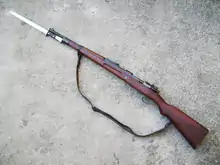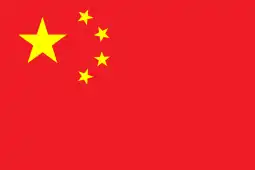Chiang Kai-shek rifle
The Type Chiang Kai-shek rifle (Chinese: 中正式), also known as the Generalissimo rifle,[3] and Type 24 (二四式), named after the Chinese Generalissimo Chiang Kai-shek, was a Chinese-made copy of the German Standardmodell rifle, the forerunner of the Karabiner 98k. Preproduction of the Chiang Kai-shek rifle started in 1935 (year 24 of the Republican calendar, hence the Type 24). It was designated the Type 79 by the Chinese Communists.
| Type 24 / Type Zhongzheng | |
|---|---|
 Type Chiang Kai-shek rifle/Type 24 rifle | |
| Type | Bolt action rifle |
| Place of origin | Republic of China |
| Service history | |
| In service | 1935–1980s |
| Used by | See Users |
| Wars | |
| Production history | |
| Designed | 1934 |
| Manufacturer | Gongxian,[lower-alpha 1] Hanyang, Jinling and Canton Arsenals[1] |
| Produced | 1935–1949 |
| No. built | ~600,000 |
| Specifications | |
| Mass | 4.08 kg (9.0 lb) |
| Length | 1,110 mm (44 in)[2] |
| Barrel length | 600 mm (24 in) |
| Cartridge | 8×57mm IS (7.92×57mm Mauser) |
| Action | Bolt action |
| Rate of fire | 15 rounds per minute |
| Muzzle velocity | 810 m/s (2,657 ft/s)[2] |
| Effective firing range | 500 m (550 yd)[2] |
| Feed system | 5-round stripper clip, internal magazine |
The rifle was in full-scale production as early as late 1935. However, full standardization for the production of the Type Chiang Kai-Shek rifle only started during the Second Sino-Japanese war and the Hanyang 88 rifle was produced in greater numbers.
History


The weapon served as one of the main battle rifles for the Chinese National Revolutionary Army (NRA, or Nationalists). Like the Karabiner 98k, it was a shortened and lightened version of the Gewehr 98, specifically, a copy of the Oberndorf Export Mauser named Standard Modell. 10,000 had been bought by China in 1934 and the Germans provided the tooling to produce the Type 24. The 1934 materials proved to be incorrect and new tools were sent in early 1935.[4]
Although it entered production at the Gongxian Arsenal in July 1935, China's limited industrial capacity meant that the rifle was built in relatively low numbers. Initial CKS rifles were made. The name of the rifle was changed from Type 24 to Type Chiang Kai-Shek after a visit of the Generalissimo to the factory.[1]
As the war progressed, however, China's industry in western cities like Chongqing and Kunming allowed more and more of these rifles to be produced, although quality controls persisted due to the need to move machinery in order to avoid being captured or destroyed by Japanese troops.[1][5]
Together with the Mauser C96 handgun and the M35 Helmet, these weapons have become recognizable features of the Generalissimo's National Revolutionary Army during China's turbulent early 20th century.[6] In an ironic twist, the rifle, although named after Chiang Kai-shek, was also heavily used by the Communists that he fought against during the Chinese Civil War.[7]
Chinese Sergeant Tung Chih Yeh claimed to have shot and killed over 100 Imperial Japanese Army (IJA) soldiers using a Chiang Kai-shek rifle with and without a scope in the Yangtze area.[8]
In 1941 the Chinese Communists managed to make copies of this rifle, dubbing theirs the Type 55 rifle in honour of Eighth Route Army Commander-in-chief Zhu De's (later Marshal) 55th birthday.[9]
About 600,000 of all models were produced between 1935 and 1949,[10] of which ~400,000 had been produced during the war.[11]
By the end of the 1940s, the Type Chiang Kai-shek rifle was phased out from frontline service in favor of superior American aid equipment, such as the semiautomatic M1 Garand, M1 carbine, and Thompson submachine gun for the Nationalists. Despite being replaced by more modern infantry weapons, the Type Zhongzheng still served the ROC armed forces well into the 1970s as a rifle for reserve forces. The Type Zhongzheng Rifle (along with the American M1 Garand) is still used by the ROC Army as a ceremonial/parade rifle to this very day. The Chinese People's Volunteer Army used the Type Zhongzheng rifle during the Korean War alongside other small arms that were provided as military aid to the PRC by the Soviet Union. Among the weapons provided to Chinese Communist forces in Korea by the Soviet Union included Soviet capture Mauser Karabiner 98k rifles.[3] The Type Zhongzheng rifle was also seen in the hands of the Viet Minh during the final stage at First Indochina War[12] and of the Viet Cong during the Vietnam War.[13]
The Chinese People's Militia and smaller local paramilitaries were using Chiang Kai-shek rifles (as well as Arisakas and Mosin–Nagants) up until 1980 before it was replaced with more modern small arms (e.g. the Chinese Type 56 assault rifle and the Chinese Type 56 carbine) and became a supplemental ceremonial weapon (the main ceremonial rifle is the SKS) for the People's Liberation Army to the present day.[7] Many of these rifles (along with other PLA and People's Militia small arms) were used by various Red Guard factions during the Cultural Revolution in the mid- to late 1960s.[14]
Design
The major advantage of the Type Chiang Kai-shek over the Arisaka was that it had better stopping power with the use of the 7.92x57 Mauser cartridge (.323 inch bullet diameter);[5] the rifle also had a better rate of fire and a greater range than the Arisaka.[7] The weapon was shorter, (similar in length to the Karabiner 98k) when compared with the Gewehr 98 and the Arisaka Type 38[5] but firing produced more blast and recoil.[11]
The rifle can have a HY1935 bayonet attached with the same Mauser bayonet lug.[15]
Users
 Republic of China (1912-1949): National Revolutionary Army, various Chinese Warlords[6] and pro-Japanese Collaborationist Chinese Army[16]
Republic of China (1912-1949): National Revolutionary Army, various Chinese Warlords[6] and pro-Japanese Collaborationist Chinese Army[16] China: People's Liberation Army, called the Type 79[3]
China: People's Liberation Army, called the Type 79[3].svg.png.webp) North Vietnam: Viet Minh[17] and Viet Cong[13]
North Vietnam: Viet Minh[17] and Viet Cong[13]
See Also
Notes
- Sometimes known as Kung Hsien Arsenal in certain translations.
References
- Ness & Shih 2016, p. 251.
- Ness & Shih 2016, p. 258.
- Smith, Joseph E. (1969). "Chinese rifles". Small Arms of the World (11 ed.). Harrisburg, Pennsylvania: The Stackpole Company. p. 294.
- Ness & Shih 2016, p. 250.
- "中正式步枪:作用有限的抗战利器(图)". chinanews.com (in Chinese). 5 February 2015.
- Yeung, Norton (March 31, 2016). "An Unexpected Partnership: Nazi Germany and the Republic of China".
- "火器堂 - 奮戰八年 - 中正式步騎槍". www.chinesefirearms.com.
- Bolt Action: Empires in Flames: The Pacific and the Far East by Andy Chambers, page 39.
- "55式步枪的来历,55式步枪".
- "奋战八年--中正式步骑枪" (in Chinese). Archived from the original on March 31, 2007.
- Ness & Shih 2016, p. 263.
- Notes on the Viet Minh Army on the final stage of the Indochina war, The War Office, June 1956, p.25
- Rottman, Gordon L. (10 Feb 2009). North Vietnamese Army Soldier 1958–75. Warrior 135. Osprey Publishing. p. 25. ISBN 9781846033711.
- Smith, Joseph E. (1969). "Chinese communist militia weapons". Small Arms of the World (11 ed.). Harrisburg, Pennsylvania: The Stackpole Company. p. 299.
- "Chinese Mauser Chiang Kai Shek or Zhong Zheng Shi : : C&Rsenal". surplused.com. Archived from the original on 2018-09-01.
- Jowett, Philip S. (2004). Rays of the Rising Sun: Armed Forces of Japan's Asian Allies 1931-45: Volume 1: China and Manchukuo. Helion & Company Limited. p. 75. ISBN 9781906033781.
- Tucker-Jones, Anthony (30 August 2017). Dien Bien Phu. Pen and Sword. p. 28. ISBN 9781526708007.
- Ness, Leland; Shih, Bin (July 2016). Kangzhan: Guide to Chinese Ground Forces 1937–45. Helion & Company. ISBN 9781910294420.